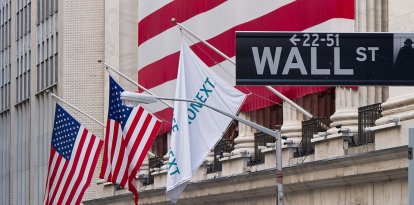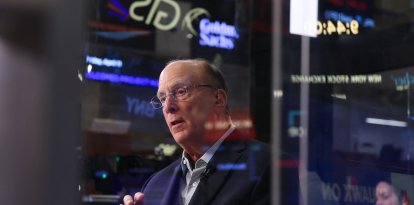2023, a year on strike
Thousands of workers in the country initiated work stoppages in search of better pay and working conditions.
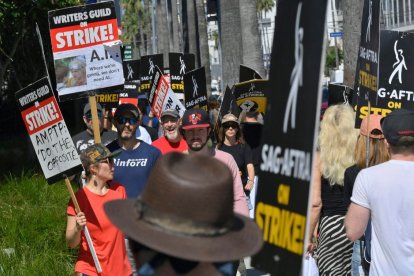
(Cordon Press)
2023 may be best remembered for the number of strikes that started and were resolved throughout the year. This was seen especially in the latter half of the year, when workers from many sectors decided to picket, backed by the different unions they belong to.
These stoppages affected several sectors, including entertainment, health, transportation and even education, whose workers all decided to fight for better working and economic conditions.
WGA puts down its pencils
The first big stoppage was carried out by Hollywood screenwriters, who began their strike on May 2. The Writers Guild of America (WGA), which contains the writers of movies and TV shows made in the country began a strike that would last 148 days and which officially ended on Sept. 27.
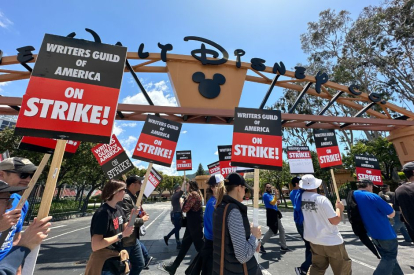
Screenwriters demonstrate at the entrance to Walt Disney Studios.
They demanded better salaries, a law that would protect them against the use of artificial intelligence (AI) and better legislation on royalties, the benefits that screenwriters receive every time their products are rebroadcast on a streaming platform.
The problem that was most difficult to solve was AI. The new agreement ruled that AI will not be able to write or rewrite literary material. It was also determined that scripts written using this technology would not be considered original material and that screenwriters could only use artificial intelligence as a work tool if they had approval from the studios. Studios are also not allowed to force these workers to use this technology in their writing and must inform them whether scripts are made using AI or not.
Another important issue was royalties, which was also resolved. Starting in September, video on demand (VOD) services were required to share their audience data with the WGA, including the number of hours played worldwide for any production. Thus, the union could confirm that the writers received fair pay for their work. In addition, the percentage of royalties was also determined in the new agreement, ranging from 50% to 76% depending on different factors.
SAG-AFTRA joins the WGA
It didn't take long for actors to join the screenwriters and completely paralyze the film industry in the United States. When the writers' strike began May 2, actors had already been showing support for their industry colleagues.
However, their fight had not yet begun. That happened on July 14 , when the actors' union, SAG-AFTRA, decided to also start its own strike, which ended on Nov. 9, after 118 days.
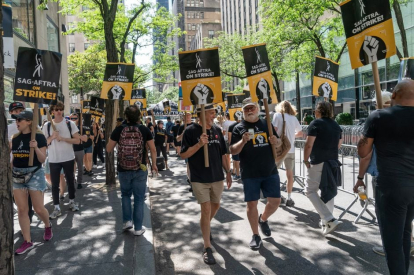
Picket of Hollywood actors and screenwriters demonstrating in New York during the double strike that is devastating the sector.
Their strike was also relevant because actors were unable to attend shoots, grant interviews or take part in large-scale events such as Comic-Con. This left the studios without any marketing opportunities and forced them to negotiate with both unions.
In fact, the negotiations with SAG-AFTRA, although they were difficult, had a small precedent, since the requests made by the interpreters were similar to those raised by the screenwriters. Actors were demanding higher salaries, regulation on royalties, better working conditions and limiting the use of artificial intelligence to have guarantees that the actors will not be replaced by AI.
In the case of actors, the most complicated thing to regulate was the use of artificial intelligence, though they managed to make rules in the new agreement, thus putting an end to the largest double strike in Hollywood since 1960.
Auto workers' historic strike
As if the United States couldn't get enough of the strikes from actors and screenwriters, the auto industry soon began its own strike. In this case, the pickets were concentrated in the different plants in the country belonging to Ford, Stellantis and General Motors, with nearly 13,000 employees stopping work as of Sept. 15.
This stoppage was defined by the leader of the United Auto Workers (UAW), Shawn Fain, as "historical," since it was the first strike in the 88 years of union history in which the employees of the three large corporations carried out a simultaneous strike after failing to reach an agreement with the salary offers for their workers: “For the first time in our history, we will strike in all three at the same time,” Fain explained when announcing the pickets.
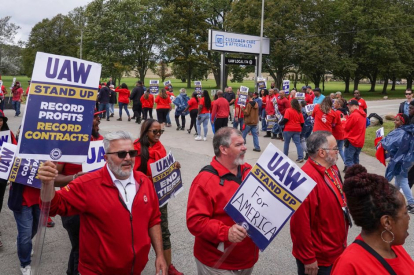
Image of the AUW strike held on September 26 in front of the General Motors plant in Michigan.
The stoppage continued until Nov. 18, when the last group of employees, Ford's, managed to reach an agreement. Among the requests made by the union was a 36% salary increase over four years. What they were looking for, specifically, was to achieve, in that period of time, a salary of $32 per hour.
As the UAW explained, new employees start earning a salary of $17 per hour and take almost a decade to reach $32, something they viewed as unfair. Along with this, they also asked for a 32-hour work week with 40 hours of pay.
Health workers also on strike
At the beginning of October, 75,000 healthcare employees also joined the various strikes called throughout the country. In a stoppage that affected six states, the strike lasted 72 hours and was called by the workers of Kaiser Permanente, one of the main healthcare providers in the United States. Their union had been in negotiations since April but, ultimately, they were unable to reach a deal.
Their demands included a 27% salary increase over the next four years, an increase in minimum wage to $23 per hour in California and $21 per hour in markets outside of California, an update to the Shared Performance Plan, improving existing health benefits and retirement income plans as well as renewing assistance programs and training for registration.
The strike was called in 39 hospitals in California, as well as in other health centers in Colorado, Oregon and Washington. In Virginia and Washington, D.C., pickets were held, but only for 24 hours.
Doctors were the only workers who did not join the strike. Vocational nurses, sonographers, respiratory therapists, emergency department technicians, housekeepers, healthcare assistants, administrative staff, cafeteria and cleaning employees, optometrists and laboratory technicians did.
Los Angeles, a city of strikes
California was the state that saw the most strikes, and the city where there were the most stoppages was, without a doubt, Los Angeles. There, throughout this year, hotel workers, public workers and teachers alike decided to protest in search of better economic conditions.
Hotel employees (including cleaning staff, bellboys, waiters and receptionists) began their strike a few days before the actors, on July 2. They claimed that the salaries they received were insufficient compared to the high cost of living in Los Angeles.
For this reason, the union that represents them, Unite Here Local 11, demanded an increase of $5 per hour, as well as an annual pay increase of $3 per hour over two years. They also demanded more financial aid for housing, better healthcare, a pension and a change in working hours.
On Aug. 8, more than 11,000 public employees in Los Angeles went on strike. They alleged that the local administration led by Karen Bass exercised "unfair labor practices" with officials, in addition to agreeing to review their contracts. The stoppage became the most important in the Los Angeles public sector in the last 15 years.
Months earlier, several education workers staged their own pickets in Los Angeles. In March, workers at the Los Angeles Unified School District (LAUSD) began a strike to protest "bad practices" carried out by the school district. Several demonstrations and protests were held in front of schools.
Around 65,000 employees (including bus drivers, janitors, assistants and teachers) supported that stoppage. The strike lasted three days and affected some 420,000 students.
RECOMMENDATION





